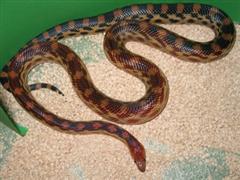Gopher Snake - Cape
Pituophis melanoleucus vertebralis
Sat, 12th July, 2025 - 4:03 am GMT
Sponsor Ads:

Alternative Name
Pituophis melanoleucus vertebralisBasic Info
Individual specimens of Cape Gopher Snakes vary greatly in coloration. They are usually very heavily marked, with red or orange shaped blotches at the front of the dorsal surface and black, square blotches at the rear. In the middle of the body, there is a gradual transition from one type of marking to the other. The background color is usually yellow, red, orange or brown, although some animals from the northern part of the region are significantly darker. The Cape Gopher Snake's head is usually free of markings, although they may exhibit shading from dark orange to yellow or white. The head is narrow with tall lateral surfaces that end in a square at the dorsal surface. The neck is thinner than many snakes of the same family. Cape Gopher Snakes usually average between 36 and 66 inches, or 91.5 to 168cm, in length. Two varieties of Cape Gopher Snake exist in captivity. These are the "normal" variety, in which breeders have encouraged the orange and red colorations, and the "hypomelanistic" variety. The second variety has been so named by the black pigmentation at the front of the body that has been greatly reduced.
Health
In captivity, Cape Gopher Snakes are fed on mice and rats. They are content with either pre-killed or live food. They should not be fed at high temperatures as this can cause regurgitation, as can feeding them large animals. Warm temperatures can also cause behavioral problems. The Cape Gopher Snake prefers cooler temperatures than most other snakes and should not be kept at temperatures higher than 78 or 79 degrees Fahrenheit (25-26C). If the ambient cage temperature is less than 78 degrees, a basking spot about 80 degrees should be provided. They should be provided with a shallow water dish that will not spill, as the Cape Gopher Snake prefers dry conditions. Breeding To breed Cape Gopher Snakes, they should be placed in hibernation between late November and late February. Temperatures during hibernation should fluctuate between 55 and 53 degrees Fahrenheit (12.8-18.3C). After hibernation, mating will begin within about five weeks. The females usually breed prior to their first spring shed. About 45 days after copulation, the female lays clutches of between five and ten eggs. The laying usually begins after the first shed. Healthy, well-fed females may lay two clutches. The eggs should be incubated in moist vermiculite at about 82 degrees Fahrenheit for around 70 days.Habitat
They also live in tropical forests and scrubland as well as in the Sonoran desert and along the coast. Most specimens have been found in the scrublands, but they do exist in the other areas as well. Cape Gopher Snakes prefer arid environments, although tBehavior
The Cape Gopher Snake is a moderately sized snake native to the Baja Peninsula. Two varieties are available to prospective owners: the normal variety and the hypomelanistic, with reduced black pigment at the rear of the body. Nocturnal animals, the Cape Gopher Snake is active only at night. This may be in defense of the very hot daytime temperatures often associated with the Baja Peninsula. Nighttime temperatures are often drastically cooler. As mentioned above, they spend their day in underground burrows that are quite cool. The overall picture is a snake that enjoys cool weather, despite its home in a very hot area. It is unknown what the Cape Gopher Snake feeds on in the wild. They are also active.Origin
North AmericaHistory
While living only in the southern tip of the Baja Peninsula, the Cape Gopher Snake can be found in a variety of different habitats. They live in the Sierra de la Laguna, a very high mountain with dense forests.Common Foods
It is most likely that they eat small rodents, such as mice and rats. They may also feed on lizards. In captivity, Cape Gopher Snakes are very nervous animals.Sponsor Ads:
Never put off till run-time what you can do at compile-time. -- D. Gries
Gopher Snake - Cape
Coded by: BGID® | ALL RIGHTS RESERVED Copyright © 2000-2025
Disclaimer | Privacy | Report Errors / Contact | Credits
















